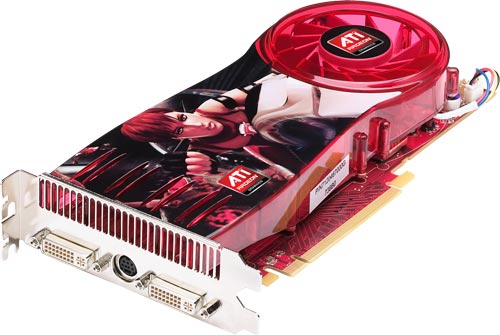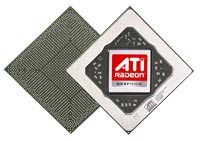
When the R600 GPU hit the scene last May in the form of the Radeon HD 2900 XT, it wasn't very well received by enthusiasts for a few key reasons. For one, the Radeon HD 2900 XT generally consumed more power and generated more heat than NVIDIA’s already well established GeForce 8800 GTS. In addition, the 2900 XT was also louder, more expensive, and also didn't quite perform as well as the 8800 GTS, not to mention it was missing UVD support. A home run product the Radeon HD 2900 XT was not.
From a technical standpoint, however, the R600 was promising. It had full DX10 support, top notch image quality, gobs of memory bandwidth, and a number of innovations like HDMI output with audio and new anti-aliasing modes. After testing the Radeon HD 2900 XT and watching it mature in the marketplace these past few months, we couldn't help but wonder how the R600 would have been received had AMD built the chips using a more advanced manufacturing process that could help mitigate some of its fundamental shortcomings.
We can stop wondering now it seems. Today is the day AMD has chosen to officially unveil the RV670 GPU, a derivative of the R600, manufactured using a 55nm process. The RV670 will be the GPU that powers the new ATI Radeon HD 38x00 series of graphics cards. However, we should point out that the RV670 isn’t a straight-up shrink of the 90nm R600. In this iteration of the 55nm RV670, AMD has also tweaked the GPU in a few areas in an effort to increase relative performance and efficiency.
We’ve had a quartet of RV670-based cards in house for a short while and have put them through the wringer with an entirely new and up-to-date test-bed running Windows Vista Ultimate and powered by a Quad-Core Intel Core 2 Extreme CPU. Read on for the full scoop...

|

|
| ATI Radeon HD 38x0 |
| Features & Specifications | |
| 666 million transistors on 55nm fabrication process
256bit 8-channel GDDR3/4 memory interface
Ring Bus Memory Controller
- Fully distributed design with 512-bit internal ring bus for memory reads and writes
- Optimized for high performance HDR (High Dynamic Range) rendering at high display resolutions
Unified Superscalar Shader Architecture
- 320 stream processing units
- Dynamic load balancing and resource allocation for vertex, geometry, and pixel shaders
- Common instruction set and texture unit access supported for all types of shaders
- Dedicated branch execution units and texture address processors
- 128-bit floating point precision for all operations
- Command processor for reduced CPU overhead
- Shader instruction and constant caches
- Up to 80 texture fetches per clock cycle
- Up to 128 textures per pixel
- Fully associative multi-level texture cache design
- DXTC and 3Dc+ texture compression
- High resolution texture support (up to 8192 x 8192)
- Fully associative texture Z/stencil cache designs
- Double-sided hierarchical Z/stencil buffer
- Early Z test, Re-Z, Z Range optimization, and Fast Z Clear
- Lossless Z & stencil compression (up to 128:1)
- Lossless color compression (up to 8:1)
- 8 render targets (MRTs) with anti-aliasing support
- Physics processing support
Full support for Microsoft DirectX 10 / 10.1
- Shader Model 4.0
- Geometry Shaders
- Stream Output
- Integer and Bitwise Operations
- Alpha to Coverage
- Constant Buffers
- State Objects
- Texture Arrays
Dynamic Geometry Acceleration
- High performance vertex cache
- Programmable tessellation unit
- Accelerated geometry shader path for geometry amplification
- Memory read/write cache for improved stream output performance
Anti-aliasing features
- Multi-sample anti-aliasing (up to 8 samples per pixel)
- Up to 24x Custom Filter Anti-Aliasing (CFAA) for improved quality
- Adaptive super-sampling and multi-sampling
- Temporal anti-aliasing
- Gamma correct
- Super AA (CrossFire configurations only)
- All anti-aliasing features compatible with HDR rendering
CrossFire Multi-GPU Technology
- Scale up rendering performance and image quality with 2 or more GPUs
- Integrated compositing engine
- High performance dual channel interconnect
|
Texture filtering features
- 2x/4x/8x/16x high quality adaptive anisotropic filtering modes (up to 128 taps per pixel)
- 128-bit floating point HDR texture filtering
- Bicubic filtering
- sRGB filtering (gamma/degamma)
- Percentage Closer Filtering (PCF)
- Depth & stencil texture (DST) format support
- Shared exponent HDR (RGBE 9:9:9:5) texture format support
ATI Avivo HD Video and Display Platform
- Two independent display controllers
- Drive two displays simultaneously with independent resolutions, refresh rates, color controls and video overlays for each display
- Full 30-bit display processing
- Programmable piecewise linear gamma correction, color correction, and color space conversion
- Spatial/temporal dithering provides 30-bit color quality on 24-bit and 18-bit displays
- High quality pre- and post-scaling engines, with underscan support for all display outputs
- Content-adaptive de-flicker filtering for interlaced displays
- Fast, glitch-free mode switching
- Hardware cursor
- Two integrated dual-link DVI display outputs
- Each supports 18-, 24-, and 30-bit digital displays at all resolutions up to 1920x1200 (single-link DVI) or 2560x1600 (dual-link DVI)
- Each includes a dual-link HDCP encoder with on-chip key storage for high resolution playback of protected content
- Two integrated 400 MHz 30-bit RAMDACs
- Each supports analog displays connected by VGA at all resolutions up to 2048x1536
- HDMI output support
- Supports all display resolutions up to 1920x1080
- Integrated HD audio controller with multi-channel (5.1) AC3 support, enabling a plug-and-play cable-less audio solution
- Integrated Xilleon HDTV encoder
- Provides high quality analog TV output (component / S-video / composite)
- Supports SDTV and HDTV resolutions
- Underscan and overscan compensation
- HD decode for H.264/AVC, VC-1, DivX and MPEG-2 video formats
- Flawless DVD, HD DVD, and Blu-Ray playback
- Motion compensation and IDCT (Inverse Discrete Cosine Transformation)
- HD video processing
- Advanced vector adaptive per-pixel de-interlacing
- De-blocking and noise reduction filtering
- Edge enhancement
- Inverse telecine (2:2 and 3:2 pull-down correction)
- Bad edit correction
- High fidelity gamma correction, color correction, color space conversion, and scaling
- MPEG-2, MPEG-4, DivX, WMV9, VC-1, and H.264/AVC encoding and transcoding
- Seamless integration of pixel shaders with video in real time
- VGA mode support on all display outputs
PCI Express 2.0 x16 bus interface
OpenGL 2.0 support

|
There is some pertinent information related to today's launch available on our site that we recommend you read, to get familiar with AMD's new ATI RV670 GPU, their previous GPU architectures, and their key features. The Radeon HD 3870 and 3850 are based on a GPU derived from of the R600, and as such they have a number of key features in common that we've already covered in much greater detail that we will here today. The articles we suggest you peruse include:
If you haven't already done so, we recommend scanning through our 2x00 series coverage, our CrossFire Multi-GPU technology preview, and the Radeon X1950 Pro with Native CrossFire article. In those four pieces, we cover a large number of the features offered by the new Radeon HD 38x0 series and explain many of the features of DirectX 10. We recommended reading these articles because there is quite a bit of background information in them that'll make it easier to digest what we're going to showcase here today.

![]()







